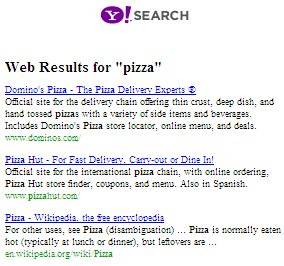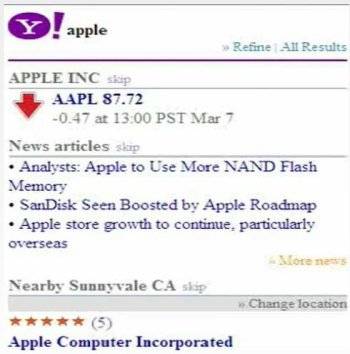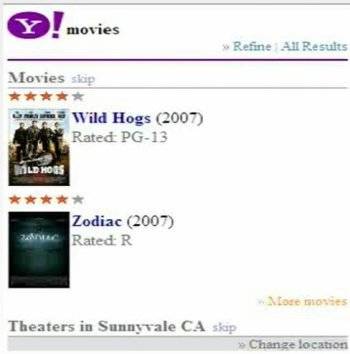On Tuesday Yahoo will significantly expand the reach of their new mobile search
product, Yahoo! oneSearch, by making it
the default mobile Yahoo homepage at http://m.yahoo.com
for US users. In effect this brings oneSearch, which Yahoo launched in January
2007, to the Mobile Web
masses. The US masses anyway – it will be rolled out to other countries and languages in
the coming months. To clarify, oneSearch was initially only available in the Yahoo! Go for Mobile 2.0 package, but as of Tuesday it
will become available on more than 85 percent of US mobile phones through the Mobile Web.
Another way of putting it – Yahoo is replacing the old ‘1.0’ m.yahoo.com site with its
upgraded ‘2.0’ oneSearch product.

In this post we examine the new features that US mobile Web users can expect from
Yahoo. Also check out this
screencast for a full video explanation, which is an exclusive to
Read/WriteWeb.
Here is a simple illustration of the changeover from the old y.mobile.com page
(designed for mobile phones) to the new:

The most obvious change is that it has become a purely search-centric homepage
for mobile phones, whereas the old site had both search and a kind of mini-portal.
There is more than meets the eye though. When you actually do a search, there is a lot of
added functionality in oneSearch – that wasn’t there before. oneSearch tries to provide
context when searching for something on your mobile phone, recognizing that on a
phone you need different types of info than on a PC.
Yahoo #2 in Mobile Search, behind Google
A little background to the Mobile Web market. According to the December 2006 stats from M:Metrics, Yahoo! Search is currently the #2 search
service on mobile phones for the US market:
Google 4,889,881
Yahoo! 3,523,725
MSN Mobile/MSNBC 530,831
Current mobile network 4,315,345
So oneSearch is obviously aimed to challenging Google for that top spot.
Yahoo and the Mobile Web
Before we look at some examples of oneSearch and its feature set, a few words about
how Yahoo is managing its Mobile Web products…
Yes there will be advertising in oneSearch, including sponsored search results
and display advertisements. So monetization has been built into oneSearch from the
get-go.
Distribution and partnerships is key in the mobile world. Yahoo’s Director of
Mobile Web Lee Ott told me over the phone that Yahoo has partnerships with over 80
handset manufacturers (LG, Samsung, Nokia, etc) and carriers.
Another thing worth noting… Lee Ott told me that in the mobile world, there are
thousands of different devices, with many different browsers and rendering.
Whereas of course the PC world has just a couple of main browsers (and several smaller
ones, which are not dissimilar in rendering to IE and Firefox). So oneSearch won’t
actually look the same on every phone. But Yahoo has created a mobile platform, which it
says understands how phones render content and so gets around that ‘thousands of devices’
problem.
Mmmmm, Pizzaaaaa
OK let’s get down to the nitty gritty – how does oneSearch work? An example given in
the screencast is searching for a pizza. oneSearch will return you details of local pizza
places, including phone numbers and address details. There are added niceties, like being
able to click the “call” link to actually call that number, or you can also easily change
your location if you want a pizza place elsewhere.

oneSearch also gives you extended details, relevant to mobile phone users, which are
generally just one click away. In the pizza example, clicking on one of the results
brings up a mobile page like this:

You’ll notice the community ratings and reviews, which is by now a common feature on
Yahoo properties (and most other ‘web 2.0’ sites too). Extending this to mobile is a nice
value add. The ratings and reviews come from various Yahoo properties, like Y! Local, Y!
Search and Y! oneSearch.
Compare this to the old m.yahoo.com, which when you search for “pizza”, gives you a
fairly basic PC-centric list of results:

So already it’s clear that oneSearch gives users much more helpful results than the
old service.
oneSearch for research or movie info
Yahoo is also promoting oneSearch as a research tool for your mobile phone. The
example in the screencast is a search for “apple”, which displays this:

The top results are stock quotes, news articles, stores that are near you, product
information. All of these results are supposed to be more useful to you while you’re
mobile, than they would be if you’re on a PC.
Movies is another example given, where you get movie details in your location, user
reviews, theatre locations, news about the movie, etc.

Conclusion
There’s a lot more functionality in oneSearch, which the
screencast does a good job of covering. There are two main takeaways here though:
1) Yahoo is making Mobile Web search much more of a mobile-native product, than
something that has been simply ported from the PC to the mobile phone. You could argue
the 1.0 version of m.yahoo.com was just a stripped down bunch of links to Yahoo
properties. The new Yahoo oneSearch seems to do a much better job of giving ‘on the go’
users information that is useful to them in a mobile context.
2) The second takeaway is that Yahoo is launching oneSearch, on Tuesday, to basically
the entire Mobile Web in the US. The main mechanism for accessing it is WAP (Wireless Application Protocol) – which
is a technology with a bad reputation, due to early unsuccessful efforts at mobile Web in
the dot com era. But forget the bad connotations of WAP, the reality is it’s still the
primary method of accessing the mobile Internet. So this launch of oneSearch to the
Mobile Web is a big step forward for Yahoo. It’ll be interesting to see if Google
responds by ramping up its own mobile search service.









